
A Top 10 of gardens you want to visit
[caption id="TheBestofEnglishGardens_Feature" align="aligncenter" width="1024"]
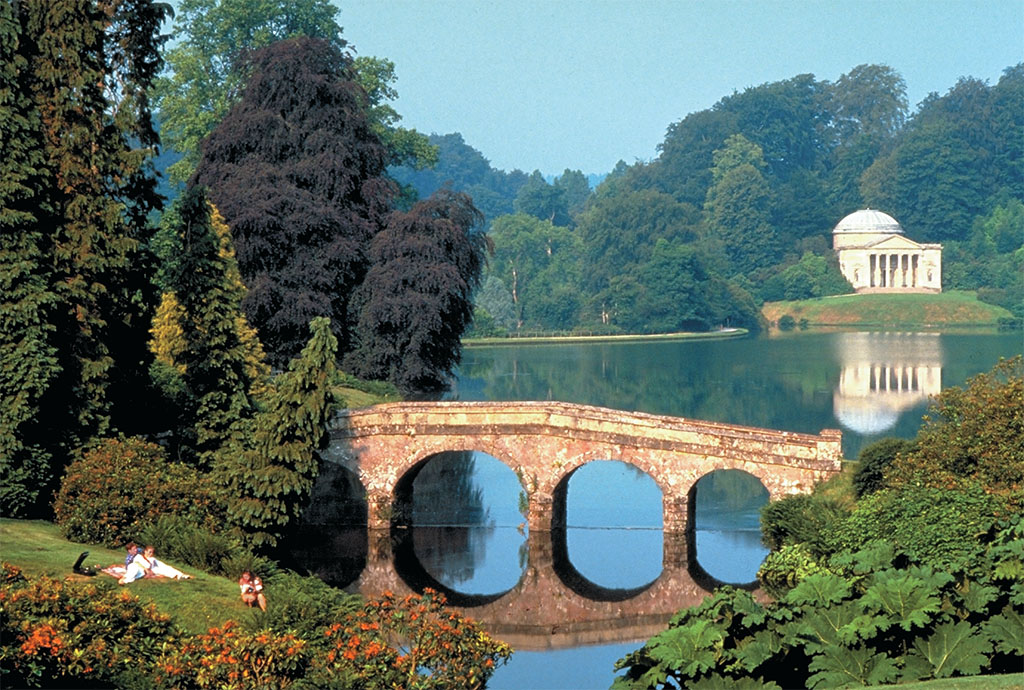
BRITAINONVIEW
As diverse and wonderful an island as Great Britain is, there are a few classic icons we associate with this green and pleasant land: proper tea and medieval cathedrals, crumbling castles, the Royal Family, real ale…and gardens. Of all the attractions that draw visitors to England, perhaps none is so strong as the profusion of English gardens. They never disappoint, and there is always one at hand. Here are some perennial favorites—the Best of English Gardens.
Kew Gardens—The Royal Botanic Gardens, Kew
[caption id="TheBestofEnglishGardens_img1" align="alignleft" width="253"]
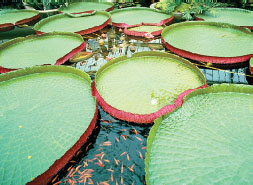
BRITAINONVIEW
You don’t have to venture into the country to enjoy great gardens. In fact, one of the greatest in the world, the Royal Botanic Gardens at Kew, is in London itself. One in eight of the world’s total plant species is reputedly represented in the exhaustive collections at Kew Gardens. Don’t bother to count; just enjoy. What you see during your own visit will depend upon the season. With gardens covering 300 acres, however, it is unlikely you will see all of Kew in a single visit.
Apart from acres of planted gardens, trees and shrubs—and the new Xstrata Treetop Walkway—Kew’s historic Victorian conservatories provide an all-weather world-class garden in their own right. The 1860 glasshouse known as the Temperate House was once the largest plant house in the world, and remains the world’s largest surviving Victorian glasshouse. Fittingly, it contains the world’s biggest indoor plant—a Chilean wine-palm that rises 52 feet. It may be the Palm House, though, that is Kew’s most recognizable structure. Built in the 1840s, the glasshouse is a virtual indoor tropical rainforest, where many of the protected palms and cycads are species that are threatened in the wild. Next door, you’ll want to visit the Waterlily House—the hottest of Kew’s hothouses. The giant waterlilies are an amazing sight.
Other collections at Kew include a new Alpine house, bamboo garden, aquatic gardens and herbarium, ferns, orchids, roses, azaleas, rhododendron and lilacs. If perchance you tire of the flora, you can catch a change of pace at Kew Palace. The smallest of Britain’s royal palaces, Kew was the royal residence where King George III and Queen Charlotte brought up their large family.
Stourhead, Mere, Wiltshire
[caption id="TheBestofEnglishGardens_img2" align="alignleft" width="253"]
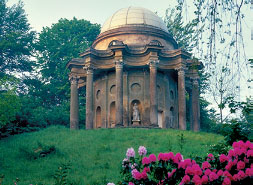
IAN SHAW/ALAMY
Long known as the “Flagship of the National Trust,” Stourhead is quite simply England’s finest 18th-century landscape garden. The 1700s saw a dramatic change of fashion in the gardens of the landed wealthy and powerful. Instead of the knot gardens and formal parterres of Tudor times and continental places, a desire to get back to nature came into vogue—or rather to rearrange nature so that it still looked “natural.” These were the days of folk like “Capability” Brown, who transformed complete landscapes, adding lakes and ponds, rearranging geography, constructing follies and reconstructing sight lines so that “every prospect pleaseth.”
Any season of the year, every prospect pleases at Stourhead. Built between 1740 and 1780 by a wealthy London banker, Henry Hoare II, the garden spills around a large lake, artificially created by damming up a stream. See the garden simply by taking a stroll around the lake, where flowering trees and shrubs and sundry rare plantings abound, where pseudo-ancient monuments, temples and a water-logged grotto accent the colorful, deliberate landscape. Stourhead is a visual delight, beloved even of people who do not like to visit gardens. If the garden stroll doesn’t leave you sated, you can visit Stourhead House, the Palladian mansion home of the Hoare family.
[caption id="TheBestofEnglishGardens_img3" align="aligncenter" width="1024"]

GREGORY PROCH
[caption id="TheBestofEnglishGardens_img4" align="alignleft" width="253"]
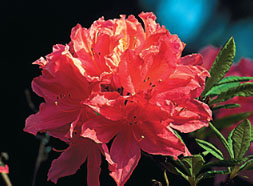
BRITAINONVIEW
Exbury Gardens, the New Forest, Hampshire
Enthusiasts affirm that Exbury is the finest rhododendron display garden in the world. Add to that the world-famous Rothschild collection of hybrid azaleas, camellias and an assortment of rare plants and herbaceous gardens. Exbury Gardens is a 200-acre woodland garden on the banks of the Beaulieu River on the south Hampshire coast, a part of the New Forest. Exbury was created in the 1920s by Lionel de Rothschild (yes, of the banking family), and his sons continue its work today.
Though it is popular for autumn color and summer gardens as well, the time to see Exbury is in the spring. The magnolias and camellias of March and early April segue into the riotous colors of the rhododendron and azaleas that are the garden’s real raison d’etre. If you are in the neighborhood, do add Exbury to your itinerary throughout the season. The time to plan a special trip down to the coast to see it, though, is May.
Sissinghurst Castle Garden, Cranbrook, Kent
[caption id="TheBestofEnglishGardens_img5" align="alignleft" width="253"]
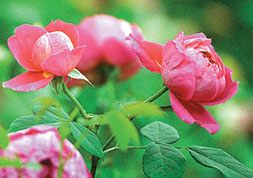
BRITAINONVIEW
There had been a moated manor house at Sissinghurst since Elizabethan times, surrounded by a deer park of hundreds of acres. The whole place was derelict and overgrown when Vita Sackville-West and Harold Nicholson acquired the property in 1930 and began its restoration. The Tudor tower remains, but it is the magnificent gardens that have justly become world famous. Largely designed by Nicholson and planted by Sackville-West, they are among England’s most popular gardens.
Having a dislike of flowers in rows, Sackville-West planted jumbled groups of flowers, themed according to color, texture and season. The result is a series of themed “rooms,” bordered by brick walls and clipped yew hedges, and connected by linking walks lined with colorful borders. From the Rose Garden to the Orchard, the creative result is a delight any flowering season. Most famous of all is the White Garden, which set something of a fashion for white gardens in southern England. Admission is restricted because of Sissinghurst’s popularity. Accordingly, time your visit for opening (11 a.m. weekdays, 10 a.m. weekends) or near the end of the day (about 4 p.m.).
Compton Acres, Poole, Dorset
[caption id="TheBestofEnglishGardens_img6" align="alignleft" width="253"]

BRITAINONVIEW
Perched on Canford Cliffs between Bournemouth and Poole, Compton Acres has long been one of my favorite gardens. In fact, there are at least seven distinctive gardens at Compton Acres. A classic Italian Garden features a large ornamental pool surrounded by seasonal bedding displays adorned with sumptuous statuary. From there, you stroll through the Palm Court and into a wooded valley with glades of foxgloves and bulb flowers, and in spring, a riot of rhododendron and camellias. A rock and water garden is next, where a maze of meandering paths takes visitors past 200 varieties of ornamental vegetation.
The Heather Garden is at its most colorful late in the season and throughout the winter. You would not have imagined so many varieties of heather exist. Perhaps the most spectacular garden, however, is the Japanese Garden. A wisteria-draped teahouse and thatched summerhouse accent water gardens laced with paths and bridges, steppingstones and Japanese statues, and pools filled with colorful koi. From Compton Acres’ cliff-top location, there are magnificent views over Poole Harbor. There is also a garden center that can keep enthusiasts fascinated for hours.
Hidcote Manor Garden, Chipping Camden, Gloucestershire
[caption id="TheBestofEnglishGardens_img7" align="alignleft" width="253"]
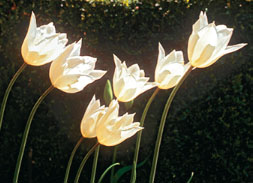
BRITAINONVIEW
Any discussion of England’s greatest gardens invariably includes Hidcote Manor in the northern Cotswolds. The setting itself, overlooking the Vale of Evesham, is spectacular. Hidcote Manor is called a garden in the Arts and Crafts style. That just means that clearly defined and geometric beds are laid out near the house, while gardens farther out are wilder and more parklike. Like Sissinghurst, the garden at Hidcote Manor is really an assemblage of outdoor rooms divided by walls and hedges of holly, yew and beech—each one distinct. They are laid out along two axes that run through a pretty gazebo in the center.
Heirloom roses and herbaceous borders, topiary and broad lawns, woodland gardens and a profusion of unusual trees and plants from around the world give Hidcote its character. Because the varied rooms are designed for varying times of peak color, any season makes a memorable visit. For the profusion and glory of the old roses, though, I favor early summer. Once again, Hidcote Manor draws crowds. If you are going on a weekend, the late afternoon is best.
[caption id="TheBestofEnglishGardens_img8" align="aligncenter" width="1024"]
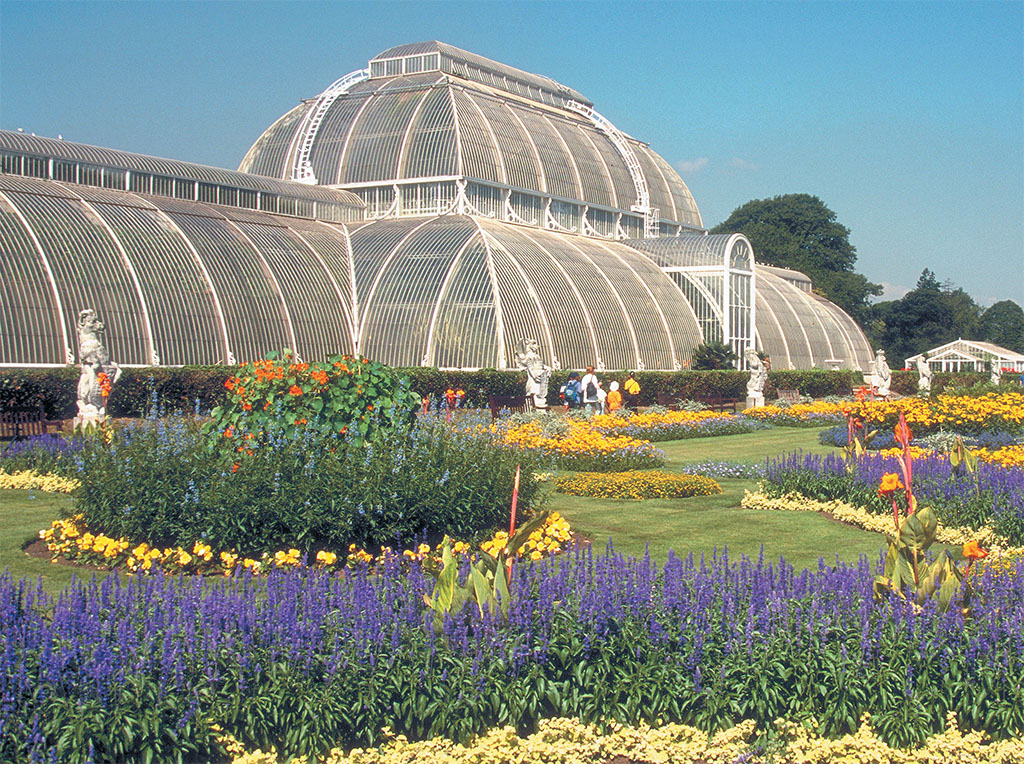
BRITAINONVIEW
Wisley Gardens, Wisley, Surrey
[caption id="TheBestofEnglishGardens_img9" align="alignleft" width="253"]

© GREG BALFOUR EVANS/ALAMY
Just outside the M25 near Woking, Wisley is the flagship garden of the Royal Horticultural Society. Fruit fields, alpine meadow, rock garden, arboretum, herbaceous borders, orchids, water plants, rare glasshouse exotics and Mediterranean garden: Every garden specialty is present on Wisley’s 240 acres. Its newest addition is a glasshouse that covers much of an acre, containing some 5,000 plant varieties.
But Wisley is not just a pretty display garden. I have always been fascinated by the trial fields, where flowers and vegetables are tested and assessed with varying cultivation techniques. Model gardens on sundry themes demonstrate how schemes can be adapted on a small scale at home. Laboratories research such things as pest control and plant diseases. And for real gardening enthusiasts, the shop contains probably the largest collection of gardening books in the country. Because of the sheer variety of Wisley, there really is no off-season. This is a delightful visit any time of year.
Biddulph Grange Garden, Stoke-on-Trent, Staffordshire
[caption id="TheBestofEnglishGardens_img10" align="alignleft" width="251"]

BRITAINONVIEW/MARTIN BRENT
The National Trust describes Biddulph Grange as a rare and exciting survival of a high Victorian garden. Unusual, eclectic and just plain fun are terms that come to mind as well. A Chinese water garden (replete with an imitation Great Wall), an Egyptian tomb, a Scottish glen, dahlia walk and Italianate terraces are a few of the elements here, all sprinkled liberally with visual surprises and follies galore. There are beautiful bedding displays and herbaceous borders as well. The varied theme gardens are hidden from each other by shrubberies and rock walls, and connected by subterranean passages and narrow paths. The net result is an eccentric delight.
Designed and built through the 1840s and ’50s by a husband and wife team, the garden was left through most of the 20th century to deteriorate, overgrow and decay. Since acquiring the property in 1988, the National Trust has spent 20 years restoring it to pristine glory. The industrial West Midlands is not a region known for gardens, but Biddulph Grange is worth a special trip.
Royal National Rose Society Gardens, St. Albans, Hertfordshire
[caption id="TheBestofEnglishGardens_img11" align="alignleft" width="253"]
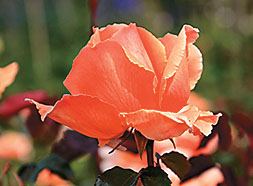
BRITAINONVIEW
Since the 1400s’ War of the Roses, the rose has been adopted as England’s national flower. Some 2,500 varieties of them are on display at the Royal National Rose Society Gardens, also known as the Garden of the Rose. Reopened now after a three-year closure for a complete redesign, these showcase gardens of the Royal National Rose Society are receiving deserved acclaim. While they are accented by a variety of flowers and companion plants, make no mistake: These are rose gardens.
With all the finesse you might expect from the world’s leading rose society, the gardens do not simply display acres of flowers. One section illustrates a history of roses and the development of rose breeding. There is also a series of model gardens, and fields for cultivar trials. If you love roses, this is the place. While the gardens are a riot of color throughout opening season, prime time to visit is early summer.
[caption id="TheBestofEnglishGardens_img12" align="aligncenter" width="1024"]

© SYLVIA CORDAIY PHOTO LIBRARY LTD/ALAMY
Trelissick, Trengwainton, Trerice, Cornwall
[caption id="TheBestofEnglishGardens_img13" align="alignleft" width="253"]

© PETER HORREE/ALAMY
To complete the best of English gardens list at a traditional 10, I nominate a trio of unusual, well-tended National Trust gardens to represent the gardens of Cornwall. Because of Cornwall’s mild southern Mediterranean climate, Cornwall’s gardens bloom with vegetation found nowhere else in Britain. While elsewhere in England gardens are still rousing into green and coaxing early bulb flowers, Trelissick, Trengwainton and Trerice are in full blossom by mid-March. It’s the place to see England’s great gardens early.
While you are in the Cornish neighborhood, you can also visit Glendurgan Garden, the Eden Project, the Lost Gardens of Heligan and the spring gardens at Lanhydrock House. In fact, in every region of England, great gardens are in the neighborhood. Another score of them deserves to be on the list, I’m sure. There are the ornate gardens of Buckinghamshire’s Waddesdon Manor, the water gardens of Studley Royal at Yorkshire’s Fountain Abbey, the famous Christopher Lloyd gardens of Great Dixter (practically next door to Sissinghurst), Leonardslee Gardens and, over the border in North Wales, Bodnant Garden. Of course, if you’ve been visiting English gardens, you are probably building your own list.
Plan Your Garden Visit
- Kew Gardens: Open throughout the year. Admission is £13. www.kew.org
- Stourhead: Open daily throughout the year. Admission £6.30. www.nationaltrust.org.uk/stourhead
- Exbury Gardens: Open daily March through early November. Admission £7.50. www.exbury.co.uk
- Sissinghurst Castle Garden: Open mid-March through October (closed Wednesday and Thursday). Admission £8.60. www.nationaltrust.org.uk/sissinghurst
- Compton Acres: Open daily throughout the year. Admission £6.95. www.comptonacres.co.uk
- Hidcote Manor Garden: Open mid-March through October, closed Thursday and, except for July and August, Friday. Admission £8. www.nationaltrust.org.uk/hidcote
- Wisley Gardens: Open daily throughout the year. Admission £8. www.rhs.org.uk/wisley
- Biddulph Grange Garden: Open mid-March to early November, closed Monday and Tuesday. Admission £5.80. www.nationaltrust.org.uk/biddulphgrange
- Royal National Rose Society Gardens: Open from early June through September, closed Monday and Tuesday. Admission £5. www.rosesociety.org
- Trelissick, Trengwainton, Trerice: Trelissick is open daily from early February to late October. Admission £6.60. www.nationaltrust.org.uk/trelissick
[caption id="TheBestofEnglishGardens_img14" align="aligncenter" width="976"]
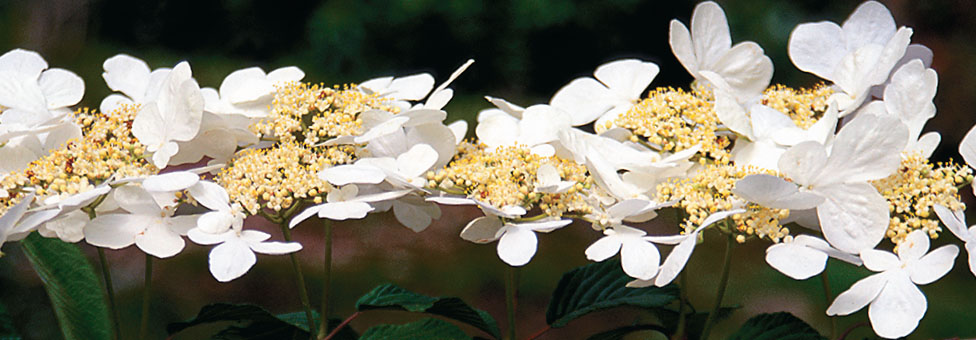
© DEREK PAYNE/ALAMY
[caption id="TheBestofEnglishGardens_img15" align="aligncenter" width="1024"]
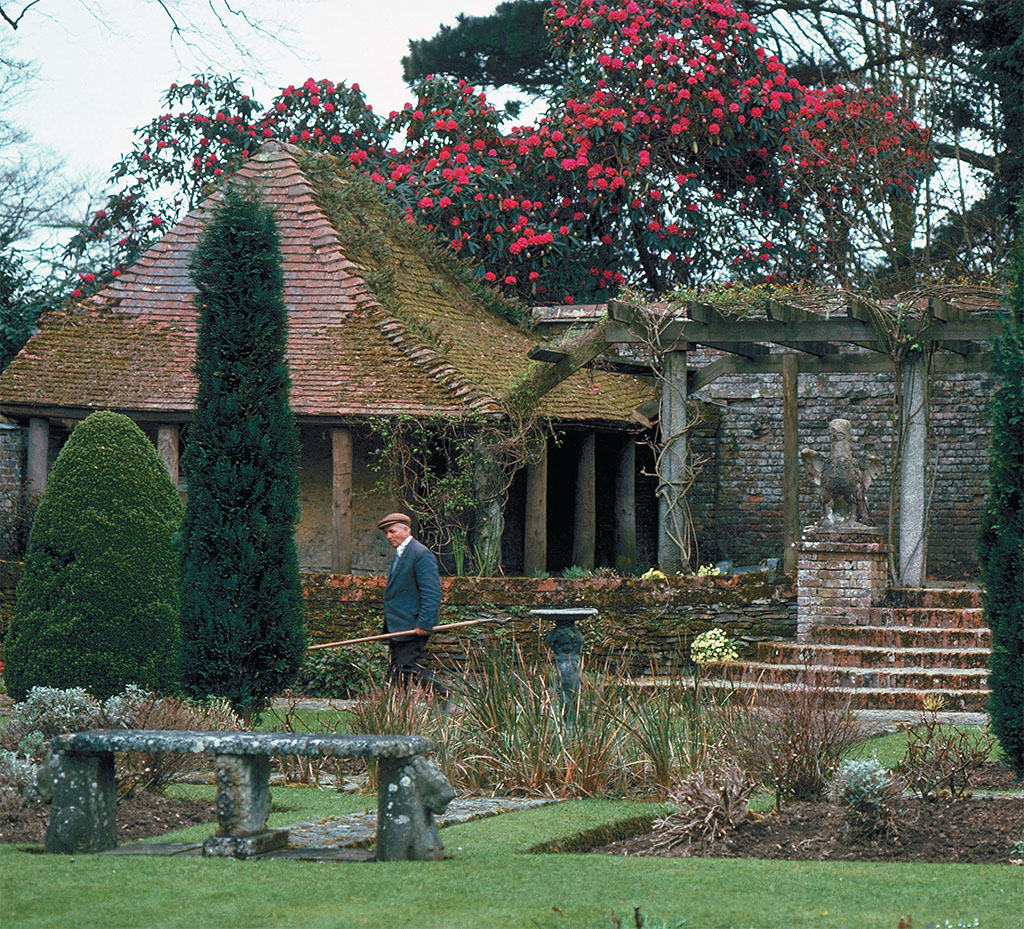
BRITAINONVIEW





Comments